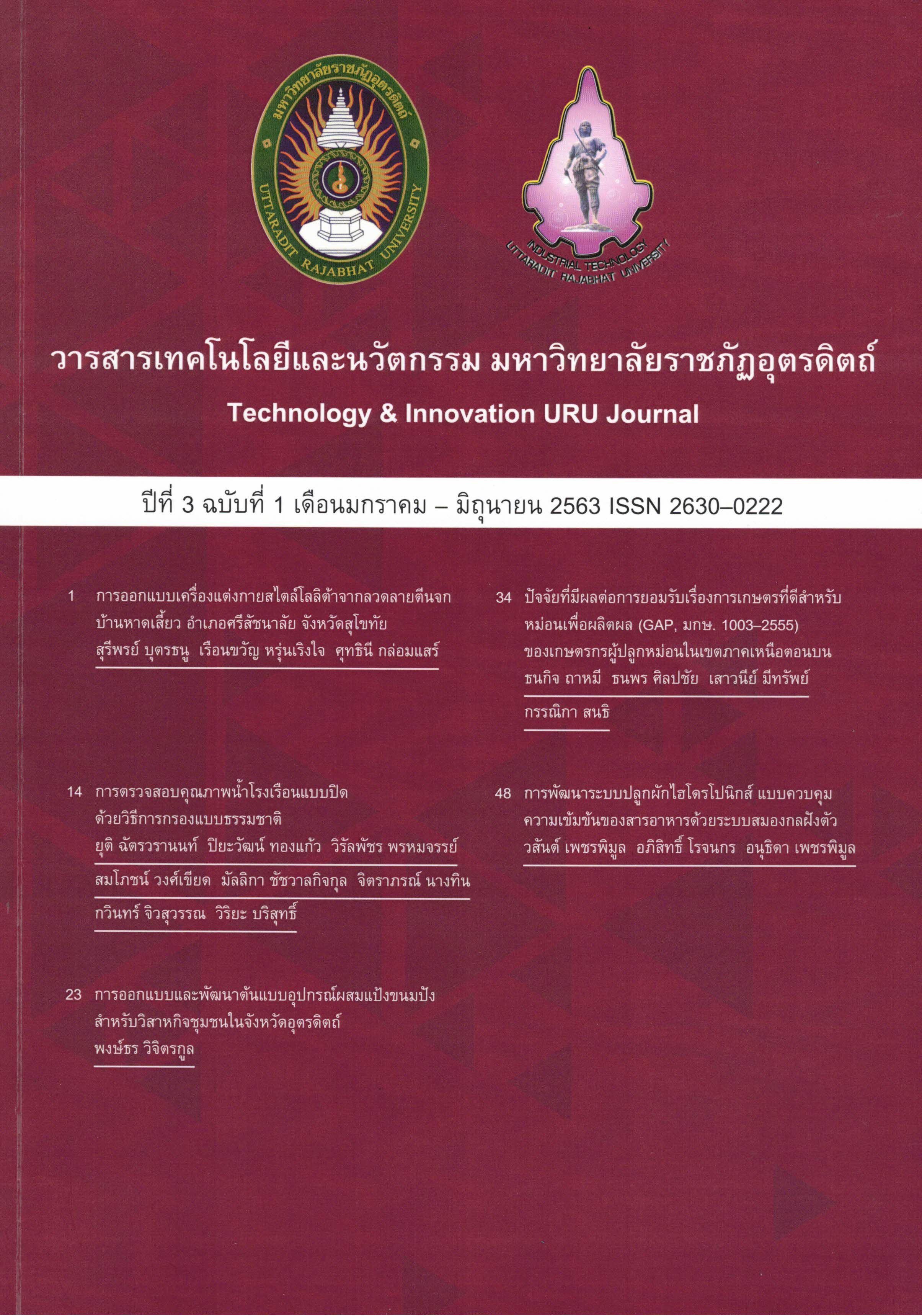Study Factor of acceptance of Thai Agricultural Standard in Good Agricultural Practices for Mulberry Fruit Production on Farmer in Upper Northern of Thailand
Main Article Content
Abstract
Nowadays the northern of Thailand had extension of mulberry fruit planting. In order that the produce have standards and safe for consumers, Therefore it extension farmers to practice with Thai Agricultural Standards (TAS 1003-2012), But this standard isn’t enforced some farmers do not apply. The objectives of this research were to study (1) the condition of the farmer of mulberry fruit produced in the north of Thailand (2) factor related to acceptance of Thai Agricultural Standard in Good Agricultural Practices for Mulberry Fruit Production (3) problem obstacles and suggestion of farmer of mulberry fruit productivity. The study was done by sampling 412 farmers in the north of Thailand in 8 provinces such as Phrae, Nan, Phayao, Chiang Rai, Chiang Mai, Lamphun, Lampang and Mae Hong Son, in 2018. The instruments used for data collection were interviewed and questionnaire. Data analyses were used descriptive statistic such as percentage, mean, standard deviation, maximum, minimum and multiple regression analysis. The results showed that From studying factor relation to acceptance of Thai Agricultural Standard in Good Agricultural Practices for Mulberry Fruit Production, it was found that the significant factors had positive relationship were year for education (or lever of education), meet with officer, it had market for sell, total area field mulberry, training, receive information from a meeting and total problems levels. For the problems of mulberry fruit productivity were the marketing in high level. While farmers' suggestions were need the government to take care of them about the marketing by management the marketing and optimum pricing for farmers, and including promoting or supporting the preservation of mulberry fruit
Article Details

This work is licensed under a Creative Commons Attribution-NonCommercial-NoDerivatives 4.0 International License.
References
ณัฐวุฒิ จันทอง, และพหล ศักดิ์คะทัศน์. (2559). การยอมรับการผลิตมะม่วงตามหลักเกษตรทีดีและเหมาะสมของเกษตรกรในอำเภอสามโก้ จังหวัดอ่างทอง. วารสารเกษตร, 32(1), 19-27.
ธานินทร์ ศิลป์จารุ. (2553). การวิจัยและวิเคราะห์ข้อมูลทางสถิติด้วย SPSS (พิมพ์ครั้งที่ 11). กรุงเทพฯ: เอส อาร์ พริ้นติ้ง แมสโปรดักส์.
พิสิทธิ์ เข้มมี. (2555). การยอมรับเทคโนโลยีการปลูกข้าวนาโยนของเกษตรกรในอำเภอบางระกำ จังหวัดพิษณุโลก. วิทยานิพนเกษตรศาสตร์มหาบัณฑิต มหาวิทยาลัยสุโขทัยธรรมาธิราช.
ยุทธพล ทองปรีชา, และดุษฎี ณ ลำปาง. (2554). ความรู้ ทัศคติและการปฏิบัติในการใช้ปุ๋ยอินทรีย์ในการปลูกข้าวของเกษตรกรอำเภอแม่สรวย จังหวัดเชียงราย. วารสารเกษตร, 27(1), 1-10.
วิวัฒน์ ภู่พร้อม, และศิริวรรณ แดงฉ่ำ. (2554). ปัจจัยที่มีผลต่อการยอมรับการเกษตรดีที่เหมาะสมของเกษตรกรผู้ปลูกผักใน อำเภอโพธาราม จังหวัดราชบุรี. ใน การประชุมวิชาการนานาชาติวิทยาศาสตร์และเทคโนโลยีทางการเกษตร ครั้งที่ 1. (น. 1-11). มหาสารคาม: มหาวิทยาลัยราชภัฏมหาสารคาม.
สมบัติ กองภา, จิราลักษณ์ ปรีดี, ขนิษฐา เกลาเกลี้ยง, และชาติ ศรีแสง. (2550). ปัจจัยที่มีผลต่อการยอมรับเทคโนโลยีการปลูกหม่อนเลี้ยงไหมของเกษตรกรผู้เลี้ยงไหมในกลุ่มจังหวัดร้อยแก่นสาร (รายงานวิจัย).กรุงเทพฯ: กรมหม่อนไหม.
สหภาพ ไตรยวงค์, สมใจ ภูมิพันธุ์, และ ไพศาล แน่นอุดร. (2560). การยอมรับการปลูกข้าวหอมมะลิคุณภาพดีตามการปฏิบัติทางการเกษตรที่ดีของเกษตรกรในจังหวัดร้อยเอ็ด. วารสารมหาวิทยาลัยราชภัฏร้อยเอ็ด, 11(2), 230-238.
สำนักงานมาตรฐานสินค้าเกษตรและอาหารแห่งชาติ. (2555). การปฏิบัติทางการเกษตรที่ดีสำหรับหม่อนเพื่อผลิตผล. กรุงเทพฯ: กระทรวงเกษตรและสหกรณ์.
สำนักงานหม่อนไหมเฉลิมพระเกียรติฯ เขต 1 จังหวัดแพร่. (2560). รายงานผลการดำเนินงานของสำนักงานหม่อนไหมเฉลิมพระเกียรติฯ เขต 1 จังหวัดแพร่ ประจำปี 2560. กรุงเทพฯ: กรมหม่อนไหมฯ.
อนุวัฒน์ รัตนชัย, ธนัญญา วสุศรี, วาริช ศรีละออง, กฤติกา ตันประเสริฐ, และศิริชัย กัลยาณรัตน์. (2553). การวิเคราะห์โลจิสติกส์ขาเข้าของข้าวโพดฝักอ่อนในภาคตะวันตกและภาคกลางของประเทศไทย. วารสารวิทยาศาสตร์เกษตร, 41(พิเศษ), 179-183.
อินตา จันทะวง, พุฒิสรรค์ เครือคำ, พหล ศักดิ์คะทัศน์, และนคเรศ รังควัต. (2562). ปัจจัยที่มีผลต่อการยอมรับเทคโนโลยีการปลูกข้าวภายใต้ระบบเกษตรดีที่เหมาะสมของเกษตรกรอำเภอจำพอนจังหวัดสะหวันนะเขตสาธารณรัฐประชาธิปไตยประชาชนลาว. วารสารวิจัยและส่งเสริมวิชาการเกษตร, 36(2), 106-117.
Akudugu, M. A., Guo, E., and Dadzie, S. K. (2012). Adoption of modern agricultural production technologies by farm households in Ghana: what factors influence their decisions?. Journal of Biology, Agriculture and Healthcare, 2(3), 1-14.
Hill, R. C., Griffiths, W. E., and Lim, G. C. (2007). Principles of Econometrics (3rd ed.). New York: John Wiley and Sons.

